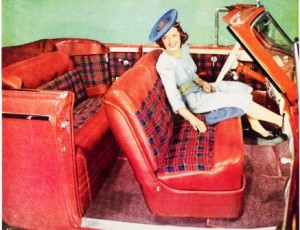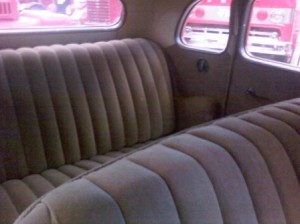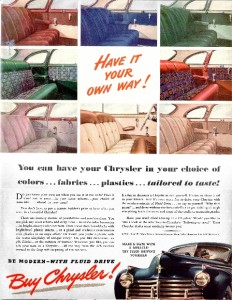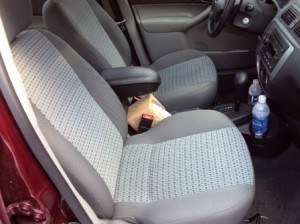My eyes were drawn to the model designation on a Toyota’s tailgate in front of me: Highlander.
How Toyota ever came by the name of a popular, colorful Chrysler model of the 1940s, I wondered. However, it also reminded me of the dullness of current car interiors compared to those of cars a few decades ago.
I once wrote a series of articles that I labeled “yoostabees” – taking off from current auto news to reminisce about cars of the past, how things “used to be.” It is time for Yoostabees to reappear.
So, it “yoostabee” that automobile interiors were, well, mousey: fuzzy grey or brown fabric seat covers and interior door panels. The interior of a restored 1935 Ford Deluxe Trunk Sedan at the Michigan Firehouse Museum in Ypsilanti is typical of the era. Further, most cars featured stamped metal instrument panels painted brown with striping intended to look like wooden panels.
According to auto historian Jeff Godshall, who before retiring led the interior design team for Chrysler’s PT Cruiser, “Regarding the change from mousy to colorful, certainly one of the first examples was Gordon Buehrig’s masterpiece, the 1936 front-drive-wheel drive Cord 810.
“Buyers of a grey Westchester sedan with dark blue broadcloth upholstery, for example, received dark blue seats, door trim panels, carpet and headliner. This alone was radically different, but in addition, the piping on the seat cushions and backs was a contrasting light grey, as was the piping accenting the headliner roof bows. The steering wheel and column, as well as the window crank knobs were also light grey. This completely color-coordinated interior fit well with the Cord’s “art moderne” exterior.
“For 1938 1/2, Chrysler introduced the “New York Special” which featured dark blue seats within a basically tan interior. In 1939, this car became the New Yorker, and started a long series of models by that name.
The first Chrysler Highlander was introduced in mid-1940 as a cream convertible with Highlander trim and an optional horn that played the notes to “The Campbell’s Are Coming, Ta-ta, Ta-ta.” (I am not kidding).
By the time Chrysler’s 1941 models came about, there was an explosion of color in Chrysler interiors. Other makes with their drab mousey greys and browns looked anemic beside the colorful Chryslers. Chrysler catalogues and color advertisements in such magazines as Life and Look displayed, well, not quite all the colors in the rainbow.
Among these, the most striking was the plaid Highlander trim. Besides the red, blue, green and black plaid with red leather accents, you could drive away your 1941 Chrysler with solid maroon, dark blue, dark green, tan, and even the old mousey interiors if you were conservative in taste.
Brief aside: I wonder what trim sets were in the two ’41 Chryslers Senator Harry Truman bought right after his re-election in November 1940? According to biographer David McCullough, HST still owned these when he turned the keys to the White House over to Ike in 1953.
Here is what the aforementioned Chrysler ad stated:
“Do you know your own car when you see it at the curb? Does it stand out as yours…in your color scheme…your choice of materials…tailored to your taste?
“You don’t have to pay a custom builder’s price to have what you want in a beautiful Chrysler!
“There are literally dozens of possibilities and combinations. You can pick any color scheme and carry it out…in subtle color harmonics…in bright, cheery color contrasts. How about sleek broadcloths with bright-hued plastic inserts…or a plaid and moleskin combination with plastic in an onyx effect? Or would you prefer a plastic with the warm simplicity of antique ivory? Do you like two-tones…or pile fabrics…or the richness of leather? Whatever you like, you suit your taste in a Chrysler…all the way from the rich exterior enamel to the deep soft carpeting of the tonneau.
“It’s fun to decorate a Chrysler to suit yourself. It’s fun to show it off to your friends.”
Chrysler continued its colorful interior choices after World War II, offering it as well in DeSoto and Dodge lines, but not Plymouth. Our family’s gunmetal grey 1948 DeSoto had a nice dark green interior, while our next-door neighbor’s white DeSoto had dark blue trim.
Beginning with 1940 models, the Chrysler Highlander was treated as a separate premium-priced series, with other cues besides the plaid trim, such as dashboard labeling. The premium for Highlander trim was $25 for 1942 Windsor models.
Postwar, Highlander trim became an extra cost option of the top series New Yorker and included exterior Highlander badging, continuing at least through the 1949 model year.
Around the time of the Korean War (1950-53), it yoostabee there were two opposing trends: (1) new car buyers promptly bought accessory seat covers to protect their pretty interiors until removed so they could be traded in with a “like new” interior, and (2) other auto makers, too, began to adopt colorful interiors.
By the middle of the 1950s, one of the big changes was adoption of color-coordinated painted instrument panels, often in pastel colors to match both the rest of the interior and the car’s pretty exterior. The instrument panel of my first new car, a ’55 Plymouth V8 Savoy coupe, was the same soft light green as the bottom half of the two-tone exterior. The rest of the two-tone green interior likewise matched the car’s exterior. Very snappy–and a big advance from the mousey grey i.p. of the hand-me-down ’52 Dodge I traded in.
The short-lived 1960 Edsel offered no fewer than 14 different exterior colors, which could be combined into as many as 40 two-tone combinations, accompanied by six different interior trims featuring turquoise, blue, red, tan, green and black. Colorful cars may have reached their peak in the 1970s when, for instance, the 1970 Pontiac GTO offered 21 exterior and six interior color choices.
Then came the imports supplying from afar and across oceans, so they kept both exterior and interior choices limited as they moved car buyers to purchasing from dealer inventories rather than custom ordering from the factory. Among other things, this diminution of choice provided importers with huge cost advantages over domestic auto producers.
“Such complexity is well nigh impossible these days,” Godshall explains, “as front and rear fascias, door handles, side view mirror shells, body side moldings, etc. are now color-keyed rather than “neutral” chrome. Inside there are more interior parts than before, especially on SUVs, which require color-keyed quarter panels, liftgate trim, floor trim, etc. Thus offering customers a choice of black, red, blue, gray, tan and green interiors would add too much complexity at assembly plants.”
And so, where once American car buyers yoostabee able to choose their car interiors from seemingly all the colors of the rainbow, now they are back to mousey greys like that in my 2007 Ford Focus. It’s not for no reason that any time in the past is referred to as “the good old days.”




